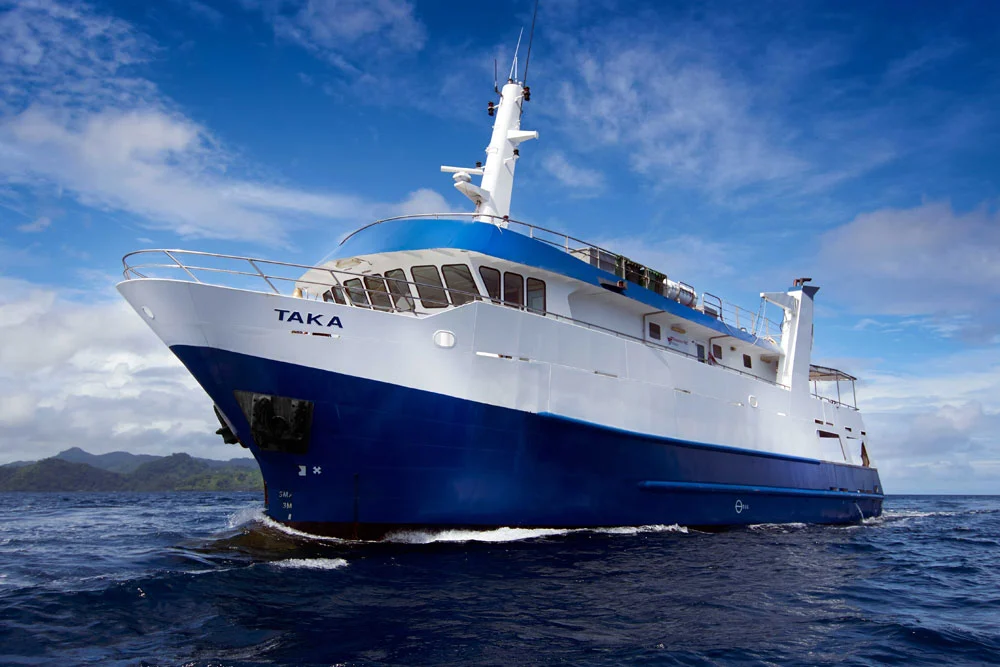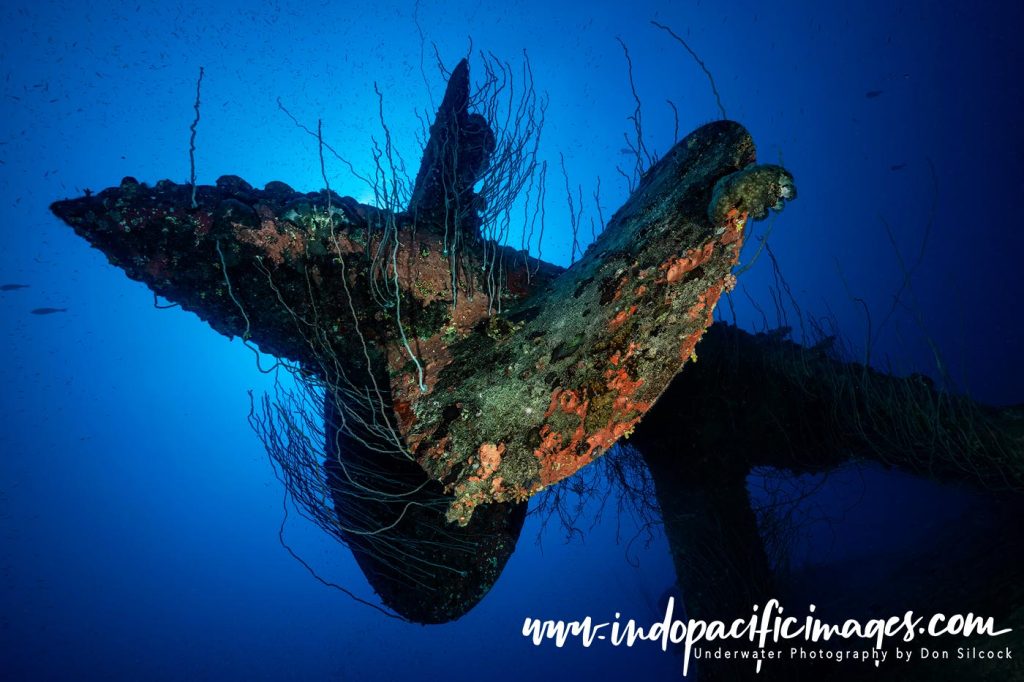
Diving on Air at Bikini Atoll… With any adventure, there’s almost always a pivotal moment when the hypothetical meets the reality.
And the full magnitude of what you are trying to do becomes apparent.
At Bikini Atoll that moment was during my first dive on the “nuclear fleet”. When, as I descended the mooring line, the wreck of the USS Anderson appeared before me.
A Sims class destroyer, the Anderson lies largely intact on her port side in 52m of water and, viewed from above, her 107m length stretched out into the distance.
The line was attached to one of the propellers and our intent was to go around the wreck and use the mooring line for the ascent.

Diving on Air at Bikini Atoll – Reality Dawns…

We had done our dive planning around a bottom time of 30 minutes. Which meant a fairly significant decompression obligation of 46 minutes.
But with twin 11l cylinders of air in a sidemount configuration, plus one 11l cylinder with 50% Oxygen and another with 90% Oxygen.
I was carrying enough gas for both me and my dive buddy (in the case of an emergency) to safely complete that obligation.
I had successfully completed all my training to dive to 55m on air and then using 50% and 90% Oxygen mixes for the decompression stops from 21m.
And I had practiced diving technically on sidemount extensively on my Solomon Islands “warm up” trip for Bikini. Plus, I had put myself through a lot of exercise with daily Crossfit sessions to get as physically fit as possible. And (the hardest part…) not a drop of beer had passed my lips for a week before. But all that preparation and practice was on the hypothetical side of the equation. As I headed deeper, I knew this was where it got very real!
Diving on Air at Bikini Atoll – The Rubber Meets the Road!
The reality side of the equation was that I about to enter into some pretty serious decompression requirements and was diving in one of the most remote locations in the world.
Above me was our boat the Pacific Master extensively equipped to dive Bikini Atoll, with a very experienced crew that really inspired confidence. But what would happen if something unexpected went wrong or I screwed up?
The nearest recompression chamber was 30 hours away in the US military base on Kwajalein. Technically however, that was a restricted area and access was not certain, in which case it was Honolulu or Australia…

It’s at times like that where I become quite analytical and balance both sides of the equation to understand what to do next. As I arrived on the bottom and adjusted my trim, I clearly remember thinking I am good. As I had done everything I could to prepare for this moment – or thought I had!
Diving Deep on Air
My decision to dive Bikini Atoll on air was based on two things – timing and cost. Firstly, I did not really have the time to get trained in what is generally referred to as “mixed gas” or “trimix” diving. Where Helium is added to the gas mix to reduce the amount of Nitrogen.
On the cost side, the war in Ukraine and the sanctions on Russia, effectively removed one of the main producers of Helium from the market. Driving the already high price of the gas through the roof and into the stratosphere! So even if enough Helium could be sourced… Diving with it in an open-circuit configuration at Bikini would have required the sale of at least one kidney…
Which left two options – dive on air or go the rebreather route and get trained on a CCR. With the former meaning the risk of decompression sickness was higher and nitrogen narcosis would be an issue. While going to CCR meant selecting a unit. And then going through the initial MOD 1 (air diluent) training and then MOD 2 (trimix diluent). Which introduced timing issues again and made diving on air the only logical option.
Diving on Air at Bikini Atoll – Nitrogen Narcosis…
I read a lot about both decompression sickness (DCS) and nitrogen narcosis before I went to Bikini. And the one thing that really stood out was neither is a linear reaction. As individual physiology can greatly impact whether you get bent or narked.
There are several things you can do in advance to minimize the risk of DCS. Such as adopting conservative Gradient Factors, resting a lot and drinking lots of water. During the dive you must follow the dive profile closely, stay calm and relaxed as possible. Plus avoid strong currents and heavy finning. When it is time to ascend and start the deco stops you obviously must follow the plan and complete them all properly. And I always spent an extra 15 minutes at 6m on 90% Oxygen as a final purge of my system. Post dive you must avoid heavy lifting or anything strenuous, drink more water and rest.
However, with nitrogen narcosis there is little you can do to minimize either its impact. Or when it hits you and it really does appear to a function of your specific physiology. That said it does produce two types of reactions when it hits and you either remain calm or get anxious. On my 55m training dives I felt calm, relaxed, and in control when narcosis set in around 40m. At depth in Bikini, I had the same sense of calm, but I later realised that infact I was not really in control at all.
Rather I was in a kind of nitrogen narcosis induced “auto-pilot” mode. Where I seemed to be doing the right things but how I would have reacted to a real emergency is anybody’s guess!

Moving to CCR
I got into technical diving so I could dive deep more safely. And embark on some wreck diving adventures in Bikini Atoll and Truk Lagoon. When I look back at what I did to prepare for and then dive the nuclear wrecks of Bikini Atoll, I believe I made logical and rational decisions overall.
It was a great and almost life-changing experience and I am determined to do more. But it’s eminently clear to me that I need to move on from diving those depths on air. And the way forward is to switch to a rebreather. If you would have asked me just three years ago, would I ever consider moving to a rebreather I would have laughed at you because they seemed like death machines!
But the more exposure I have had to them, the more I understand how they work and how they can enable safer deep diving. It’s now very clear to me that reducing the amount of Nitrogen in the gas you intend to breath at depth and replacing it with a much safer inert gas like Helium is the way to go.
It greatly reduces the decompression obligations, eliminates the narcotic impact of Nitrogen. And, believe it or not, is cheaper! As the amount of Helium and Oxygen used on closed circuit is a tiny fraction of what is used/wasted in open circuit. At Bikini my Oxygen gas bill was 3x that of the CCR divers combined Helium and Oxygen bills!
But you absolutely have to know how to prepare, maintain and dive a CCR. As they are less forgiving than open circuit equipment…
Diving on Air at Bikini Atoll – Scuba Diver Article
Scuba Diver magazine recently published a four-page version of this Diving on Air at Bikini Atoll article and you can use this link to download it.

